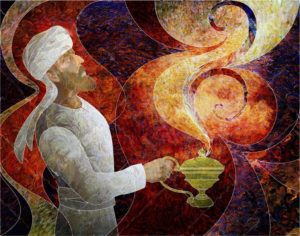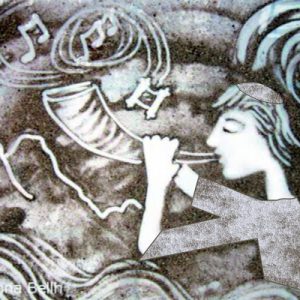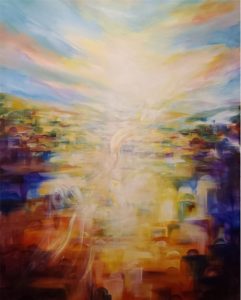 Pesach 2009 / 5769
Pesach 2009 / 5769
A Passover Teaching from A Still Small Voice
The sedar is a ritual meditation—a symbolic reenactment of our historic (and continuous) journey from exile to redemption that began nearly three and a half thousand years ago when we were born as a nation on this very eve. The whole point of a ritual is to bring light, fixing and healing into the deepest layers of the soul. Its choreography of movements, prayers and affirmations cuts to the quick. The sedar’s fifteen steps work on both the collective and individual scales.
At the fourth stage of the sedar, called yachatz (from the Hebrew word for, half) we break the middle matzah in two. The larger piece we hide and it becomes the afikomen to be eaten as dessert at the end of the meal. The smaller half stays on the table and gets eaten with our first matzah whose intention, says the hagada, is to remind us that redemption can come in the blink of an eye.
This breaking of the matzah symbolizes the inevitable fall from grace or disillusionment that propels each cycle of growth. The Talmud asserts: “You cannot own (and fully integrate) a spiritual truth unless you have first stumbled over it.” That stumbling can be a doubt about its veracity on the level of thought, a disappointment (or tragedy) on the level of emotions, or an outright rebellion on the level of action. The thing that every stumbling has in common is that it spoils the tranquility of our status quo. It forces us to grapple with an unwelcomed reality and find a way to recover our peace in spite of it.
Every growth spurt can be traced back to a symmetry-breaking moment that is symbolically reenacted when we break the middle matzah. The rest of the hagada is the path we take and the work we do to reunite these estranged pieces of ourselves and to finally, again, become whole.

The teaching goes deeper still. It is a Chassidic tradition to break the matzah into the shapes that comprise the Hebrew letter, hei, a letter that is made by combining two smaller letters: dalet and vav. 
The letter hei embodied by the matzah is the final hei of HaShem’s ineffable name. This letter represents the indwelling feminine presence of G-d called the Shekhina. It is the aspect of Divinity that shattered when Adam and Chava ate from the Tree of Knowledge of good and evil. Kaballa teaches that the freestanding leg, or vav of that final hei stayed pegged up in the higher world and did not fall when reality collapsed. It was the dalet piece of the hei that crashed and tumbled to the lower realms. The dalet associates with the word dal which means wretched, and includes all the shattered sparks of Divinity, including those enlivening the world’s despicable evildoers.
Our work is to raise that dalet, or some sliver of it, and reunite it with its long lost soul mate, the vav, that stayed pegged above. Yet like a spring compressed and released, when that dalet rises from the depths it has the momentum to overshoot its mark, and bring the whole system up another notch, vav and all. Good becomes very good, as the dalet’s fall, now reversed, propels the universe forward another step.
As above, so below. The vav is our conscious self. It includes our intrinsic identity, and all the sparks that have been raised and integrated into our constantly expanding sense of self. The dalet is our  unconscious, disowned self. It comprises all the still-fallen-sparks connected to our soul that lie outside the confines of our self-image. These sparks are no less us, yet they are hidden from us (though they can occasionally be glimpsed as the offensive traits we see in the people around us.)
unconscious, disowned self. It comprises all the still-fallen-sparks connected to our soul that lie outside the confines of our self-image. These sparks are no less us, yet they are hidden from us (though they can occasionally be glimpsed as the offensive traits we see in the people around us.)
The only thing that will ultimately make us happy is to collect all the scattered sparks of our soul and finally become whole. And this is a pleasure that is truly win–win, both for us, and HaShem. As our stature expands our union with G-d deepens, and that is the whole point of our soul’s sojourn in the earthly realms.
The afikomen (or dalet) means literally, dessert, and gets eaten as stage twelve of the sedar which is called Tsafun (hidden one). If the Temple were standing the afikomen would be the Pascal lamb, but now it is the dalet of our matzah, that was hidden by the host, then found and returned. Now, the bread of affliction becomes a delicacy so sublime that we savor its taste by refraining from food for the rest of the evening. Even chocolate mousse would be a comedown from the Pesach afikomen.
The wretched dalet that fell into the muck, exiled and disowned, now returns with a treasure trove of consciousness and is honored with the status of dessert (the extra food beyond the meal distinguished by its sweetness).
Blessings for a joyful, kosher and truly liberating Pesach where the last slivers of our fallen dalet finally jostle free and assume their status as the cosmic afikomen—the final redemption—the blessed era of growth through joy that is our messianic promise (and patiently-awaited dessert).




